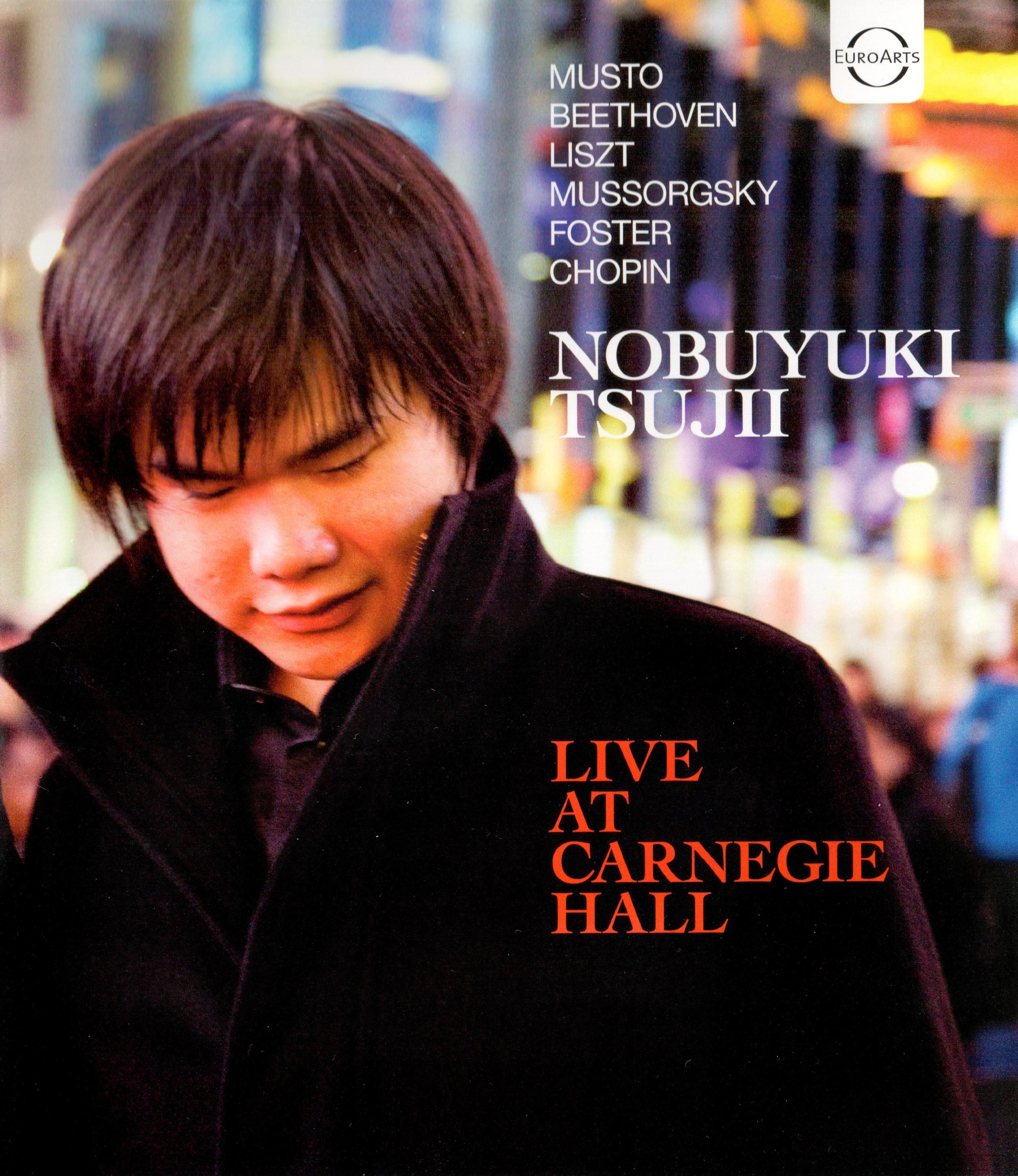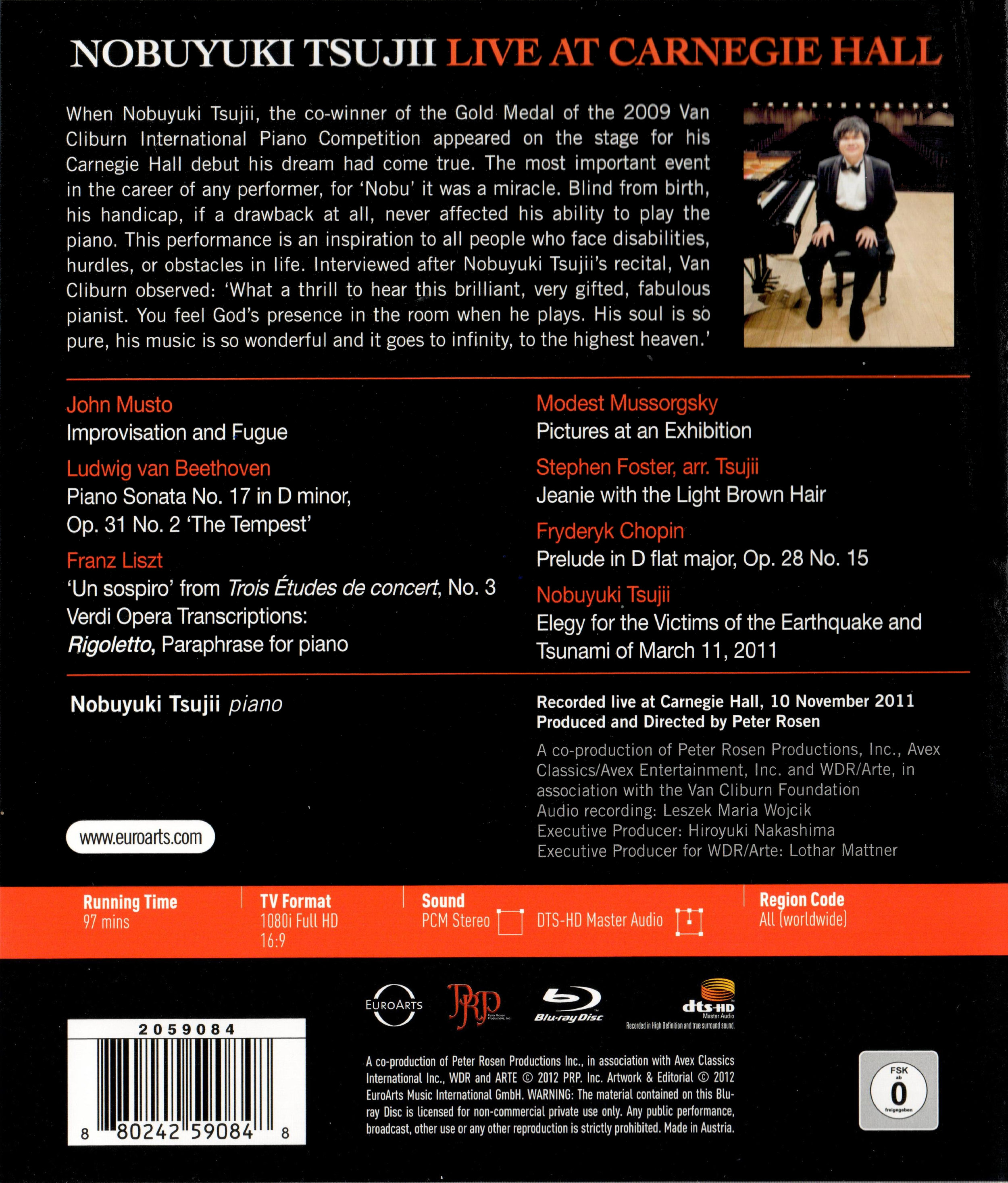

The Nobuyuki Tsujii Live at Carnegie Hall solo piano concert was performed in November, 2011. Soon thereafter, the material on this disc came out in an Avex Classics disc sold in Japan. I bought the Japanese version. I don't know any Japanese, so there were a lot of things about the Avex Classic title that I couldn't read or report on. I wished that this program would be published for the Western markets. In July, 2012, EuroArts heard by wish and granted with subject title. This EuroArts version has the same has the same music that Avex Classics released. The keepcase booklet is in English, with notes also in German and French. Now I can report that the executive producer is Hiroyuki Nakashima; audio recording is by Leszek Maria Wojcik; cameras and video recording are credited to Manny Gutierrez, David Smith, and Julie Brenckle.
Here’s the program:
John Musto Improvisation and Fugue
Beethoven's Piano Sonata No. 17 ("Tempest")
Liszt Étude No. 3, "Un sospiro"
Liszt Rigoletto Paraphrase
Mussorgsky Pictures at an Exhibition
Steven Foster "Jeanie with the Light Brown Hair," arranged by Nobu.
Chopin Prélude No. 15 "Raindrop"
Nobuyuki Tsujii "Elegy for the Victims of Earthquake and Tsunami of March 11, 2011."
This disc is region free. Released 2012, disc has 5.1 dts-HD Master Audio. Grade: A-
"Nobu," blind from birth, is a piano prodigy who learns masterpieces by ear and also composes. He may have other challenges in addition to sightlessness. For example, his head bobs about in a kind of Brownian motion that has little apparent relationship to the music he's playing or what is happening around him. This is somewhat disconcerting until you get used to it. He got his big breakthrough in 2009 at the Cliburn Competition and has since made a number of recordings. This is his first HDVD for the world market.
At the Cliburn Competition, Nobu was controversial. Some jury members thought he was too "special" to be put up against all the top sighted performers. Other jury folk found themselves sobbing as he played. And for sure, he is the very paradigm of the instant überunderdog. (Is the U.S., underdogs always win.) So the solution was to award 2 first prizes: one for Nobu and the other for the winning sighted player.
This Carnegie debut was probably made on a modest budget. The HD picture quality is not top notch. The resolution is a tad fuzzy. There is a camera on the wall behind Nobu and facing the audience that is plain, old SD (usually anathema here). No information is given about the sound sampling or other aspects of the audio recording. The piano doesn't sound as "real" as it does in the AIX Chamber Music Palisades recording with its 96kHz/24 bit sampling, but it does sound as good as the piano played by Volodos in his Vienna recital recorded by Sony.
I keep coming back to this recording, and I like it better every time I play it. Here's a pianist whose mind has never been distracted by reading notes. All he knows he got the old-fashion way: by listening to other musicians. And everything he plays he learned by heart. Funny expression that "learn by heart." Nobu's repertoire can't be very large. But everything he performs, he "plays by heart," and that's why so many people are crazy about him.
The program and performance is highly enjoyable to watch. (If you just listen, you might detect that Nobu's execution is not as rock solid as that of the top sighted players.) You also get a keen feeling for the event. The N. Y. audience was happy with and for Nobu. And this was an emotional event for the pianist also.
Nobu in front of Carnegie Hall:
Nobu bows before the concert starts. You see a camera on the front row and a robot camera on the stage. There is a round 6" hole in the rear wall through which a SD camera looks down on the pianist:
Nobu goes to work:
Here's a neat double exposure shot. The keyboard close up probably was made from a balcony camera:
Here's a keyboard shot from Nobu's left. But what camera made this? I'm guessing that a technician came on stage with a hand-held camera for this and quite a few other views. But you never see any suggestion of this from from the recording itself. Could I be missing something?
Nobu bows after his last encore, a precious, short piece in updated classical style called Elegy for the Victims of the Earthquake and Tsunami of March 11, 2011. I predict you will soon start hearing this played soon by others:
Nobu is overcome by his emotions on stage and in the wings:
Jeremy Nicholas in Gramophone (November 2012, page 67) gives this title a sympathetic review from the viewpoint of the pianist's handicap.
I showed this video to my sister. She is the best musician in our family. Her career was in special education teaching handicapped children with various disorders. After about 10 minutes, she said, "Please let me see something else. It's amazing what he can do, but his playing isn't smooth enough to for me to really want to listen to it. He just isn't competitive with the top sighted pianists on the concert circuit."
People tend to fall into two camps when exposed to Nobu: some are enthralled (like me) by his accomplishment (the romantic camp) and others find his playing lackluster (like my sister in the realist camp). This was exactly what happen to the Van Cliburn judges in Fort Worth. The solution then was to award two first prizes.
Nobu doesn't have a big repertoire, and he tends to play the same pieces a lot. He's a special case. Jeremy Nicholas (in the romantic camp) wrote a wise review of subject title in Gramophone magazine mentioned above. In the October 2014 issue of Gramophone he also wrote a generous review about Touching the Sound, a documentary about Nobu's childhood and how he got to where he is today.
I keep thinking about Nobu. He's in the same boat with sighted piano players who don't memorize and who use sheet music for their performances. One player doesn't see; the other doesn't remember. Both have to commit substantial energy to overcome their deficiencies. And both will fall short when compared to players like Hamelin, Lang Lang, Voledos, Hough, and Wang. To be on the A+ list, you have to have it all.
I keep thinking about the importance of having a video of a musical performance. When I see Nobu playing in HD, I can see what a profound, fragile, and damaged creature he is. I can see the courage that has taken him all the way around the world to play grandmaster western music on the most important stage in the United States. I see the adoring audience of romantics. It chokes me up.
But when I see a professional pianist using sheet music for an important event, I get a different feeling. Is this musician handicapped or is he just lazy? Is he asking me to pay to see what's just another hour or so of sight-reading something? It irritates me. But at least with the HD camera on my side, I can see exactly what I'm getting.
I give this Euroarts version an A-. I start with A+ and reduce the grade to A because one SD camera was used. Then I reduce further to A-for shortcomings of the performance as heard by the realistic members of the audience.










